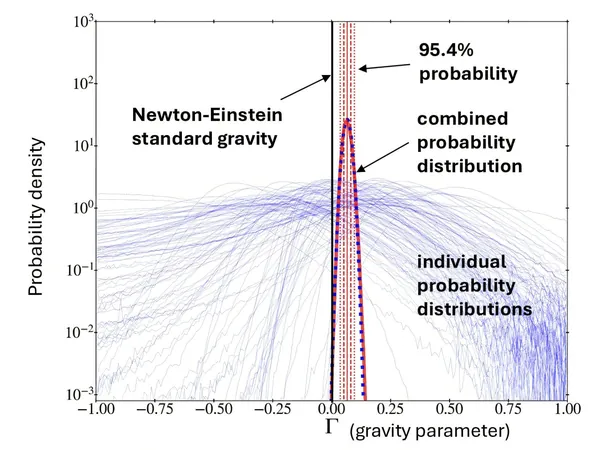
Revolutionary Study of Wide Binaries Challenges Newtonian Gravity!
2025-05-27
Author: John Tan
Discovering Gravity's Secrets Through Wide Binaries!
Wide binary stars—those separated by more than 2000 astronomical units—offer scientists unique insights into gravity at incredibly low accelerations, specifically weaker than 1 nanometer per second squared. Astrophysicist Kyu-Hyun Chae from Sejong University has pioneered a groundbreaking technique for analyzing these celestial pairs, significantly enhancing our understanding of gravitational forces.
A Game-Changing Method!
Chae's innovative approach employs 3D velocity measurements to capture a more complete picture of gravitational dynamics. Unlike traditional methods that rely solely on two-dimensional projections, this technique uses the Markov Chain Monte Carlo simulation to derive a probability distribution for a gravity parameter, making it a keystone advancement in the field, as highlighted in his study published in The Astrophysical Journal.
Chae explains, "Previous methods fell short as they were limited to projected velocities and often failed to account for uncertainties regarding stellar masses." His method overcomes these drawbacks, providing a more accurate foundation for assessing gravity in wide binaries.
Limitations and Breakthroughs!
While the method shows immense promise, it requires precise measurements of the radial velocity component. Consequently, only wide binaries with accurately gauged radial velocities can be analyzed. Chae’s first application of this method involved studying around 300 binaries from the European Space Agency’s Gaia database. Early results, though affected by Gaia’s radial velocity precision, align closely with recent findings by Chae and collaborators.
Provocative Findings!
The initial results reveal that for binaries where internal acceleration exceeds 10 nanometers per second squared, gravity aligns with Newtonian predictions. However, for binaries with lower internal acceleration (beyond 1 nanometer per second squared), gravity appears 40% to 50% stronger than Newtonian expectations—a significant discrepancy!
Endorsements from Experts!
Xavier Hernandez, a pioneer in wide binary research, commends the rigorous Bayesian method introduced by Chae, predicting it will become the standard approach in gravitational studies. Pavel Kroupa from the University of Bonn praises the clarity this research brings to gravitational theories, emphasizing the study's significant implications for theoretical physics.
Echoes of Modified Gravity!
The deviations found in Chae's study resonate with predictions from modified gravity theories established by Mordehai Milgrom over four decades ago. Milgrom himself notes the importance of these results, indicating that they reveal a departure from Newtonian dynamics akin to anomalies observed in galaxies.
The Future Looks Bright!
Chae and a team of collaborators are advancing their observations with state-of-the-art facilities, including GEMINI North and Las Cumbres Observatory. Hernandez’s team is also investigating potential hidden variables that may influence their findings.
With forthcoming data and refined methodologies, Chae anticipates exciting breakthroughs that could further unravel the mysteries of gravity. This transformative study opens doors to a deeper understanding of gravitational dynamics and its implications for our universe.



 Brasil (PT)
Brasil (PT)
 Canada (EN)
Canada (EN)
 Chile (ES)
Chile (ES)
 Česko (CS)
Česko (CS)
 대한민국 (KO)
대한민국 (KO)
 España (ES)
España (ES)
 France (FR)
France (FR)
 Hong Kong (EN)
Hong Kong (EN)
 Italia (IT)
Italia (IT)
 日本 (JA)
日本 (JA)
 Magyarország (HU)
Magyarország (HU)
 Norge (NO)
Norge (NO)
 Polska (PL)
Polska (PL)
 Schweiz (DE)
Schweiz (DE)
 Singapore (EN)
Singapore (EN)
 Sverige (SV)
Sverige (SV)
 Suomi (FI)
Suomi (FI)
 Türkiye (TR)
Türkiye (TR)
 الإمارات العربية المتحدة (AR)
الإمارات العربية المتحدة (AR)